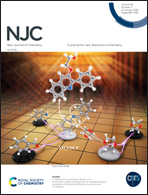Palladium(ii) complexes of 2,2′-tellurobis(N,N-diphenyl acetamide): efficient catalysts for Suzuki–Miyaura coupling at room temperature under air†
Abstract
Three complexes, [Pd(L2)2Br2] (C1), [(L2)PdCl(μ-Cl)2PdCl(L2)] (C2), and [Pd(L2)PPh3Cl2](C3) of a tellurium ligand, 2,2′-tellurobis(N,N-diphenylacetamide) ((Ph2NCOCH2)2Te = L2), reported here catalyze Suzuki–Miyaura coupling efficiently at room temperature under aerobic conditions, and the optimum loading of the catalyst is 0.001 mol% of Pd. Oxidative addition of elemental tellurium to 2-bromo-N,N-diphenylacetamide results in bis(N,N-diphenylamidomethyl)tellurium(IV) dibromide ((Ph2NCOCH2)2TeBr2) (L1). The reduction of L1 with aqueous bisulfite results in (Ph2NCOCH2)2Te(= L2). The complexes C1 and C2 were obtained by the reactions of L1 and L2 with Na2PdCl4 at room temperature in dichloromethane and ethanol, respectively. The complex C2 on reaction with triphenylphosphine results in C3. L1, L2, C1, C2, and C3 were characterized by HR-MS, 1H, 13C{1H} and 125Te{1H} NMR and IR spectra. The single crystal structures of all these compounds were determined by X-ray diffraction. The geometry of Pd in all the complexes, C1–C3, is nearly square planar. The scope of C1–C3 for catalysis of Suzuki–Miyaura coupling is reported.



 Please wait while we load your content...
Please wait while we load your content...